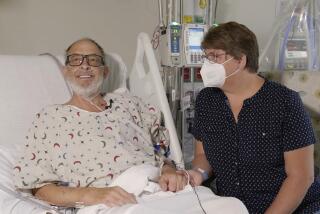Feds Ignore Transplant Site Standards
- Share via
About a fifth of federally funded transplant programs fail to meet the government’s minimum standards for patient survival or perform too few operations to ensure competency, a Los Angeles Times investigation has found.
The U.S. Centers for Medicare and Medicaid Services has allowed 48 heart, liver and lung transplant centers to continue operating despite sometimes glaring and repeated lapses, the newspaper’s review found. There are 236 approved centers nationwide.
Although many of the substandard programs treat small numbers of patients, their collective failings carry a significant toll.
Consider the latest available statistics, for transplants performed between 2002 and 2004. Nine lung programs failed to meet the minimum Medicare standards for survival, number of surgeries or both.
These hospitals accounted for 21 more deaths than would be expected, based on a government-funded analysis of how all patients fare nationwide within a year of surgery. It is adjusted for the condition of the patients and the organs.
Three dozen heart transplant programs didn’t meet federal standards for survival or volume. They accounted for 43 more deaths than expected.
Altogether, the programs examined by The Times had 71 more patients die than expected within a year of transplant.
“The bottom line message is that there are too many programs in the United States that need to be shut down,” said Dr. Mark L. Barr, a cardiothoracic transplant surgeon at USC and president of the International Society for Heart and Lung Transplantation.
The disclosure of Medicare’s failings follows a series of reports in The Times detailing dangerous lapses in oversight of the national transplant system. Three transplant centers in California have closed since September after their problems came to light.
Medicare, which funds most of the nation’s transplant centers, requires programs to perform a minimum number of transplants and to achieve a specific survival rate to be certified for funding. The benchmarks vary by organ, and there are none for kidney transplants.
Should the programs later fall short, Medicare rules mandate no sanction, only that the programs turn themselves in.
The agency has the authority to pull certification -- and therefore funding -- from any center that does not meet its standards. But it rarely does.
It has cut off funding to 11 centers since 2000. In nearly all of those cases, it moved only after the programs had voluntarily ceased operations, according to federal documents reviewed by The Times. In one case, its decertification came eight months after the program shut down.
Only recently, after The Times began asking detailed questions, did the agency step up its scrutiny. In March, it sent letters to all its approved programs, asking for information about their staffing and performance.
It already has found about 25 programs that are “seriously out of compliance” with Medicare standards, said one agency official who spoke on condition of anonymity because the findings are preliminary. Some programs have problems so severe that the agency is considering immediate decertification, the official said. That could force closure.
Some transplant surgeons say Medicare has been too permissive, continuing to support poor-performing programs abandoned by private insurers.
“This is a continued artificial bolstering of the programs that shouldn’t exist,” Barr said. To decertify such programs, he said, “would have been the natural Darwinian process to occur. The weakest in the herd get weeded out.”
The records of these centers are no secret. The Times identified the 48 programs by examining the total number of transplants performed in 2005 by each Medicare-approved center, as well as the latest survival statistics made public in January by government-funded transplant researchers. All of the information is available on the websites of the United Network for Organ Sharing and the Scientific Registry of Transplant Recipients.
Among the newspaper’s findings:
* Wake Forest University Baptist Medical Center in North Carolina logged just two heart transplants last year and since 1999 has performed fewer than the 12 required annually to secure federal funding. The federal standard is based on the principle that a hospital has to perform a certain number of procedures annually to keep its skills sharp.
When doctors at Baptist operate, their success rate has been poor. Just three of the seven patients who received a heart transplant from January 2002 to June 2004 were still alive a year later. Though the raw numbers are small, the rate is roughly half the national survival rate of 87.5% and well below the 73% threshold to receive federal funding.
* Hartford Hospital in Connecticut also has not performed 12 heart transplants in any calendar year since 1999. Six of the 17 patients who received transplants from January 2002 to June 2004 died within a year, a survival rate below 65%.
* St. Vincent Hospital and Health Care Center in Indianapolis hasn’t done the required yearly heart transplants since 2001, and it too had a poor survival rate. Of the 23 patients who received hearts from January 2002 to June 2004, eight died within a year, a survival rate of 65%.
The data could not be matched to individual patient deaths, and patients at troubled centers may never have known they were exposed to greater risks.
Centers with high death rates offer a variety of explanations, including bad luck, especially sick patients or changes in staffing. Programs that consistently perform few transplants defend their competency and say their patients would have to travel hours to another center if they were shut down.
Representatives of the programs uniformly say they should be given the time to boost their numbers or fix problems that led to unexpected patient deaths.
Officials at Wake Forest Baptist, for example, said the hospital should not be judged solely on the failures of recent years but on its long-term performance, which has been near the national average. In recent months, the hospital has hired another cardiologist and two new transplant coordinators and trained another surgeon to perform transplants.
“It’s sort of like Kobe Bryant going out and scoring 10 points for the next three games,” said Dr. Timothy Oaks, the head of heart transplantation. “You wouldn’t say, ‘He’s no good now.’ He may have a couple of bad games in a row, but you wouldn’t dismiss his previous experience.”
Although it has not acted against Wake Forest Baptist or others, the federal government did take drastic action against one program last year. It pulled funding for the liver transplant program at UCI Medical Center in Orange. But the agency moved only after The Times reported that 32 patients awaiting transplants died in 2004 and 2005 while the hospital turned down organs that might have saved some of them.
Although patients apparently did not know it, UCI had had no full-time liver transplant surgeon for more than a year, which limited its ability to perform operations. Since 2001, the facility had not performed enough surgeries annually to meet standards for Medicare, the federal healthcare program for seniors and the disabled.
Even the California Department of Health Services had pulled its funding for the program -- 18 months earlier -- because it didn’t meet the state’s own standards for the poverty program Medi-Cal.
Elodie Irvine, a former UCI liver patient who left the program because of delays in her care, later complained to the federal agency.
“They don’t care,” Irvine said. Is it Medicare’s philosophy “to just leave them open because it’s better to have a transplant center than none at all?
“Congress needs to get together. They’ve got a problem on their hands. They need to sit down, they need to gut the system.”
Earlier this year, several months after the UCI case surfaced, Medicare officials told The Times that they were not aware of any other programs that were not meeting their standards.
Now, based on the agency’s recent survey of transplant centers, regulators plan to conduct detailed inspections of questionable programs.
“In areas where there is a concern, whether it’s because they are not meeting certain volume standards or outcome standards, at a minimum, that is going to trigger a review of that specific program,” said Dr. Barry Straube, chief medical officer at the Medicare agency.
But Straube said volume is a crude measure that could unfairly tarnish some quality programs. Looking at a center’s survival rate -- and whether it is different from what is expected -- is far more important, he said.
Straube’s agency is in the process of creating a new set of rules to govern transplant centers -- perhaps lowering the number of surgeries that centers must perform each year, he said. It is a proposal that has met with heated criticism by some transplant surgeons and hospital administrators operating larger programs.
“I personally can’t get hung up on the volume issue,” Straube said. A center, he said, might do four transplants a year with 100% survival. “We should shut those down?”
Not so long ago Medicare prided itself on the good results achieved by centers adhering to its transplant standards.
Back in 1995, federal officials boasted in a press release of a new study that found that patients at Medicare-approved centers had a higher survival rate than at centers not certified by the agency.
“The results of this study suggest that setting up medical centers of excellence, which treat a high volume of transplant patients, produces better outcomes for those patients,” the Medicare agency’s then administrator, Bruce Vladeck, said in a statement at the time. “This is another validation of our approach to centers of excellence.”
Several studies have since backed up that contention.
Researchers working with the United Network for Organ Sharing, the federal contractor that ensures the safety and equity of transplantation nationwide, reported in 1994 that “mortality increased sharply and exponentially” at centers performing fewer than nine heart transplants each year. The federal standard is 12.
And as recently as last year a study found that programs performing 20 or fewer lung transplants had significantly higher lung failure rates than larger centers. The Medicare threshold is 10.
Dr. Michael Acker, a heart transplant surgeon and chief of cardiac surgery at the Hospital of the University of Pennsylvania, said he believes heart programs should be required to perform at least 20 transplants annually “to be versed enough to maintain quality.”
The reason extends beyond maintaining surgical expertise.
“It’s not just doing the transplant. It’s doing everything else,” he said. “It’s the follow-up care. It’s how to deal with immunosuppression. It’s how to deal with [patients] when they get infected. There are so many reasons for why you need a vigorous team.”
The performance of smaller programs renews questions about whether transplantation ought to be more centralized in high-volume centers. But such consolidation would likely bring strong opposition, given the prestige and convenience associated with local transplant programs.
The number of transplant centers multiplied throughout the last two decades as transplantation became more common -- and a moneymaker for hospitals.
Today, the allure of having a transplant center is so great that many hospitals hang on even though they perform fewer than a dozen surgeries a year, sometimes accepting only the lowest-risk patients to boost their success rates.
“If you remove small-volume transplant centers out of the picture, what you’ll be doing is rationing transplant services to only the large cities,” said Oaks of Wake Forest. “Someone from western North Carolina, a hillbilly redneck from here, isn’t going to go to Atlanta to live. They don’t have the means to do that.”
Private insurers say they vigilantly monitor centers’ performance because they believe patients have a better chance of surviving and lower risk of complications at centers with more experience.
Humana, an insurer based in Louisville, Ky., checks at least once a year to make sure its approved transplant centers meet its criteria, which are based on Medicare’s standards.
“We do still believe that volume has a role to play in the quality and the outcome of transplants,” said Ross Lagerblade, director of Humana’s national transplant network.
But even as private insurers have dropped or steered clear of programs with relatively high death rates and low volumes, Medicare has continued to fund them.
Private insurers used to pay for about half the heart transplants at Hartford Hospital. But those insurers now guide patients to larger centers elsewhere, including Boston and even New York, said Dr. Jonathan A. Hammond, surgical director of its heart transplant program. Perhaps it’s because the Hartford center is small and experienced some rocky years when difficulties with immunosuppression led more patients to die than expected, Hammond said.
Today, Hartford Hospital is left with just one insurer: the government. Hammond said the federal agency has never threatened to pull its support. “Medicare has never to my knowledge come to Hartford Hospital and said, ‘You have not met a minimum, and therefore we’re going to withdraw funding,’ ” he said.
And as far as Hammond is concerned, it shouldn’t. He said his program fixed the treatment issues that marred the hospital’s reputation, but the data supporting that assertion is not yet available. “If we hadn’t turned it around, we should no longer exist,” Hammond said.
The hospital now is advertising for new patients.
*
Tracy Weber may be reached at [email protected] and Charles Ornstein at [email protected]
*
(BEGIN TEXT OF INFOBOX)
Transplant standards
To qualify for Medicare funding, the U.S. Centers for Medicare and Medicaid Services require transplant centers to perform a certain number of transplants annually and achieve a specific survival rate for patients one year after surgery. Here are the federal standards for heart, lung and liver programs:
*--* Number of transplants Survival rate Heart 12 73% Lung 10 69 Liver 12 77
*--*
Transplant programs at the following hospitals failed to meet Medicare standards for both number of surgeries performed annually and one-year patient survival rates.
*--* Number of transplants Survival rate* Heart: (In 2005) Hartford Hospital (Conn.) 5 64.7% St. Vincent Hospital and Health Care Center (Ind.) 11 65.2 Wake Forest University Baptist Medical Center (N.C.) 2 42.9 Lung: University of Utah Health Sciences Center (Utah) 6 68.2 Liver: Lindy Boggs Medical Center 9 74.9 (La.) Hahnemann University Hospital 11 74.9 (Pa.)
*--*
*Reflects the one-year survival rate of heart and lung patients who received their first transplant from January 2002 to June 2004, and liver patients from July 2002 to December 2004.
For a list of transplant centers that fail to meet federal standards, go to latimes.com/transplant.
Sources: U.S. Centers for Medicare and Medicaid Services, United Network for Organ Sharing, Scientific Registry of Transplant Recipients
More to Read
Sign up for Essential California
The most important California stories and recommendations in your inbox every morning.
You may occasionally receive promotional content from the Los Angeles Times.










